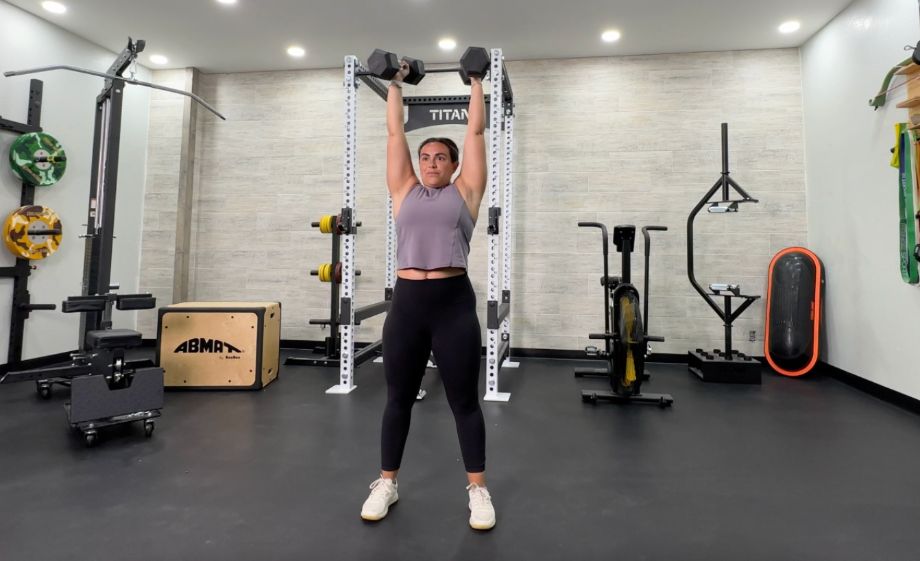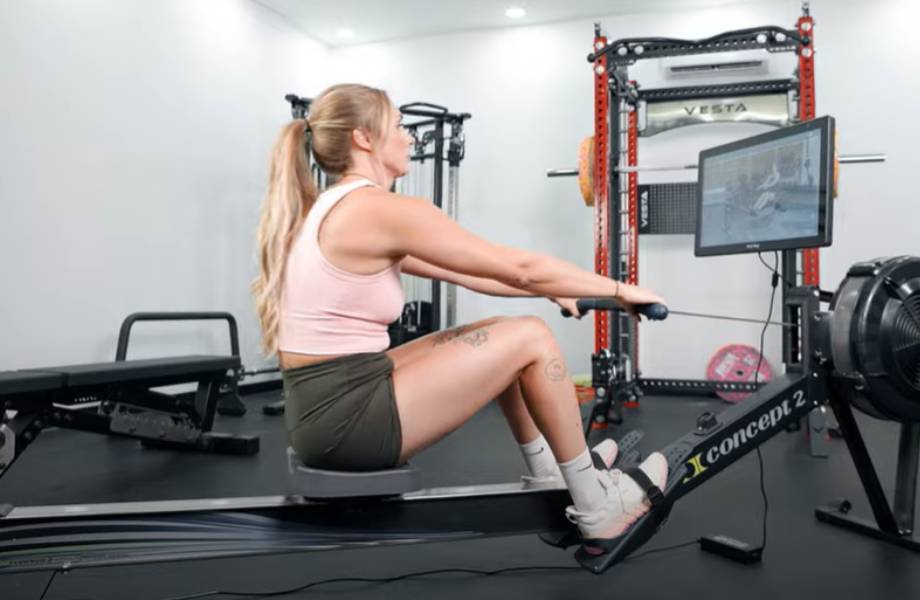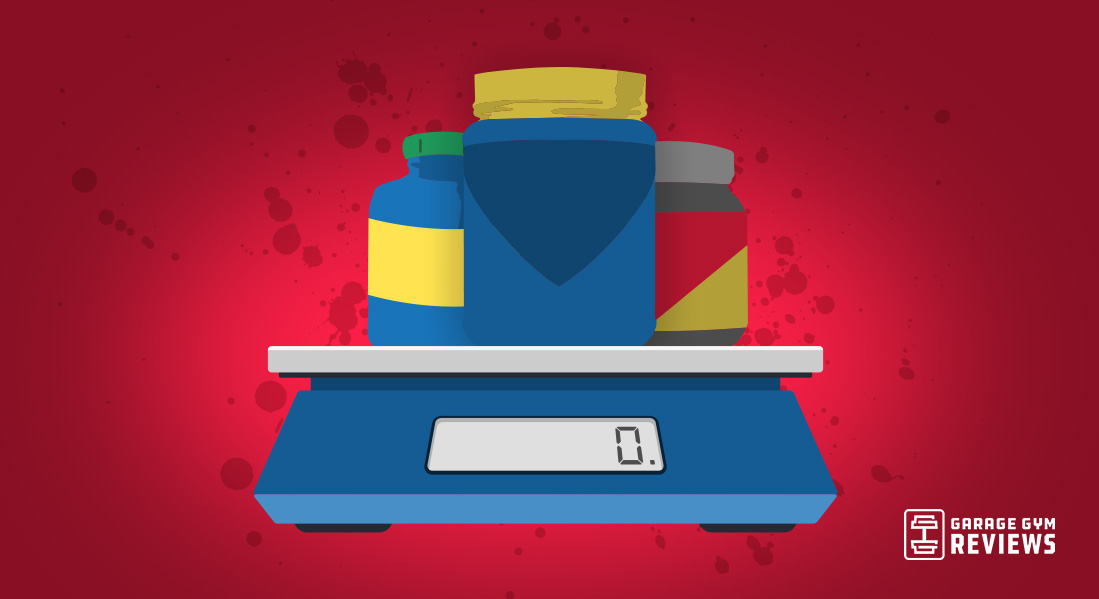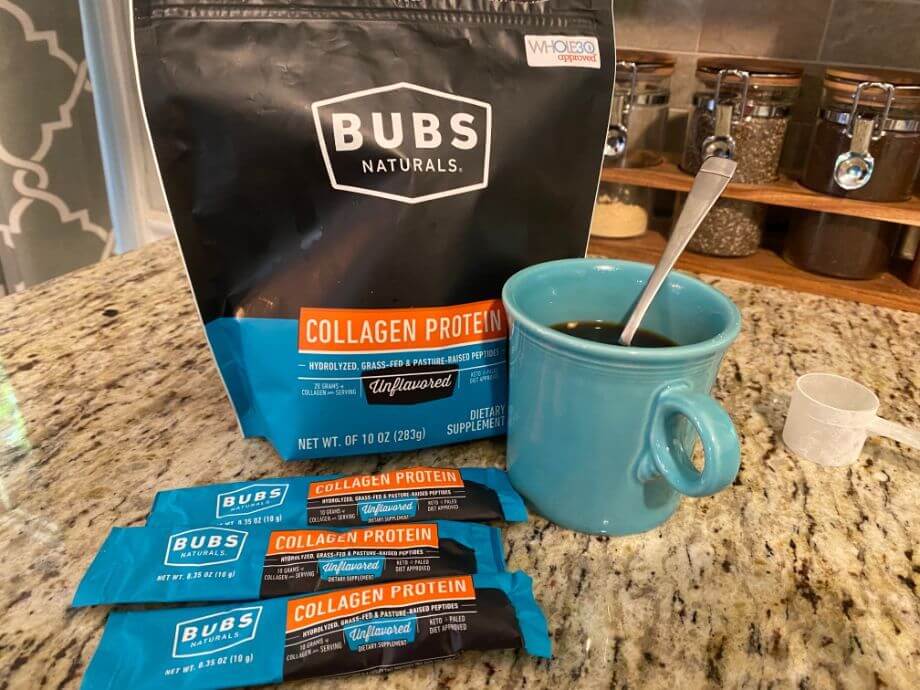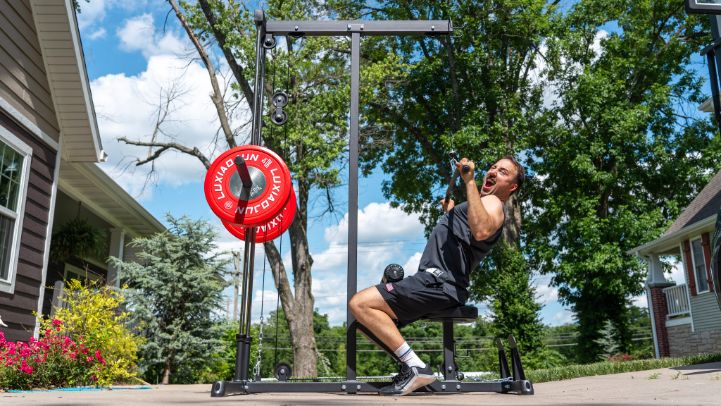Are you looking for a smart way to work out your shoulders? One of the smartest ways we’ve found is to get dumb — that is, to get a pair of the best dumbbells and get to work!
All you need is a great set of these classic free weights and you have access to some of the best dumbbell shoulder exercises available, helping you build muscle strength, size, and endurance.
Today, we’re giving a pair dumbbells its due by sharing one of our favorite shoulder workouts with dumbbells that’ll target your delts, traps, and other upper body muscle groups, so you get a killer strength workout with minimal equipment.
We’ll also discuss the anatomy of the shoulder muscle group, namely the deltoids, as well as benefits of training shoulders using dumbbells.
RELATED: Best Dumbbell Exercises
Shoulder Workout With Dumbbells
So, let’s kick things off with the real meat and potatoes — the best shoulder exercises!
We’ll tell you what makes each a great addition to your dumbbell shoulder workout and provide detailed steps on how to perform the movement with proper form.
Don’t forget to kick things off with a warm-up before you dive in!
Move 1: Dumbbell Overhead Press
Why it’s great: The dumbbell overhead press hits your deltoid muscles, as well as your trapezius, triceps, lower back, and glutes. Using dumbbells provides you a greater range of motion than a barbell would too, making the movement even more effective.
How to do it:
- Hold two dumbbells at shoulder height with your elbows bent,
- Press them overhead until your arms reach full lockout.
- Slowly return to the starting position.
- Repeat as needed.
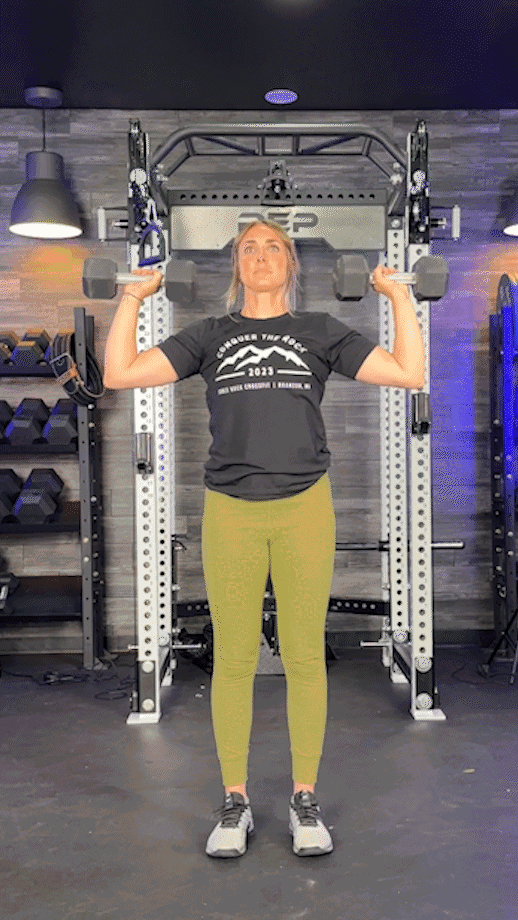
Move 2: Arnold Press
Why it’s great: In case you’re wondering, yes — the Arnold press is named for the bodybuilder turned action star turned governor Arnold Schwarzenegger himself. His version puts extra emphasis on the anterior deltoid and upper arms.
How to do it:
- Curl two dumbbells to your shoulders, keeping your palms facing your body.
- Rotate the dumbbells as you press them into the overhead position. At the top of the movement, your elbows should be locked out and your palms should face away now.
- Slowly return to the starting position, reversing the rotation as you go.
- Repeat as needed.
RELATED: A Back Workout With Dumbbells
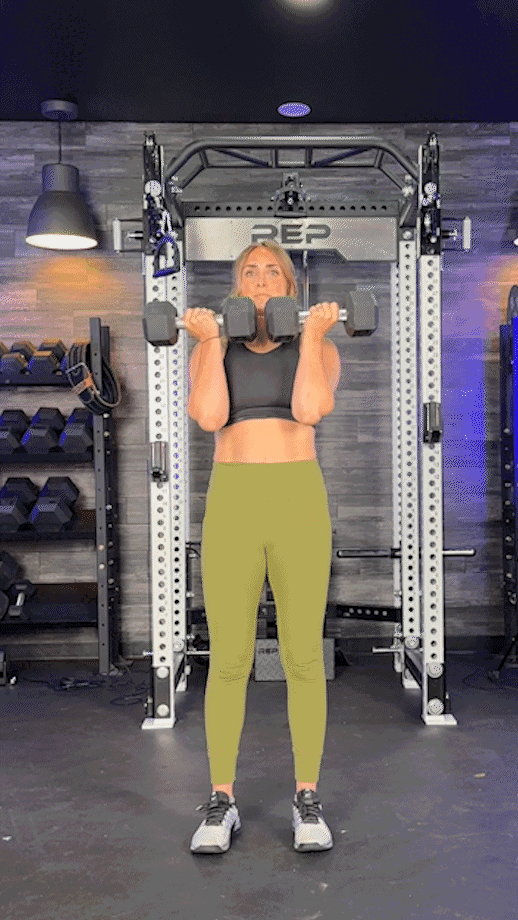
Move 3: Z Press
Why it’s great: The Z press proves that sitting down on the job isn’t always a bad thing. Like the seated dumbbell shoulder press, the seated positioning reinforces proper scapular movement, improves stability, and builds posture.
How to do it:
- Grab two dumbbells and have a seat on the floor. You may spread your legs wide or leave your feet together as though you’re about to do the classic toe touch stretch.
- Press the dumbbells overhead, holding your core tight.
- Slowly return to the starting position.
- Repeat as needed.
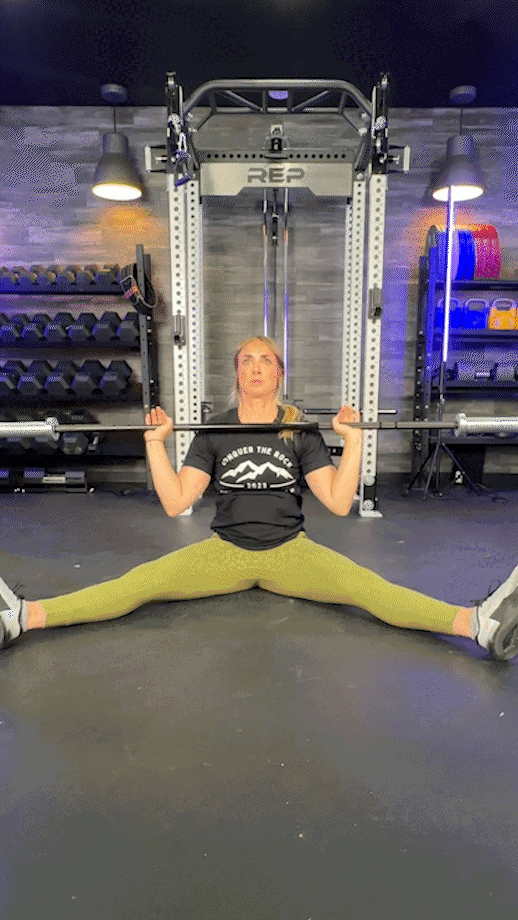
Move 4: Dumbbell Front Raise
Why it’s great: A lot of shoulder exercises involve overhead extension, but the front raise uses shoulder flexion to really isolate the anterior delts. You’ll also feel this one in the upper pecs, providing a good two-for-one deal on muscle activation.
How to do it:
- Hold two dumbbells in front of your body with an overhand grip.
- Keeping your arms straight, raise the dumbbells upwards to shoulder level.
- Slowly return to the starting position.
- Repeat as needed.
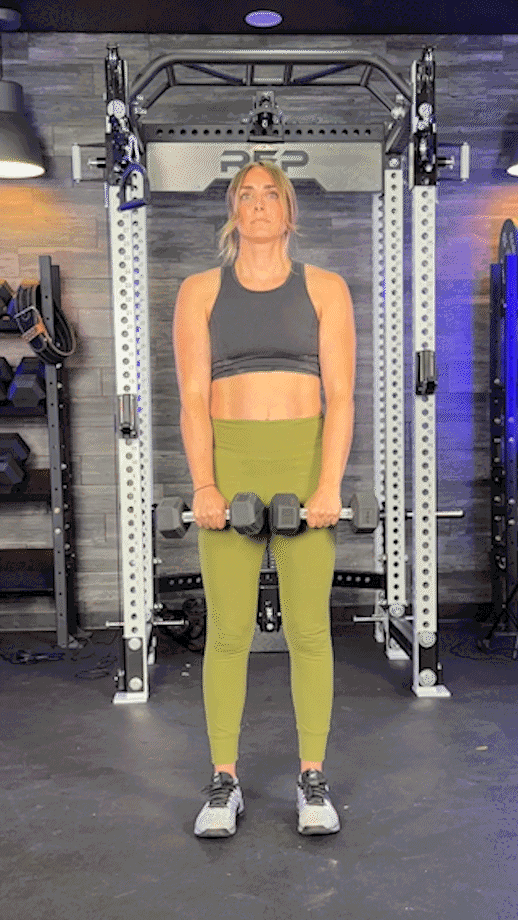
Move 5: Dumbbell Lateral Raise
Why it’s great: Lateral raises target, you guessed it, the lateral deltoids, but you’ll also feel this in the anterior deltoids and trapezius in the upper back.
How to do it:
- Hold a dumbbell in each hand with your arms at your sides.
- Keeping your arms straight, raise the dumbbells outwards to shoulder level.
- Slowly return to the starting position.
- Repeat as needed.
RELATED: A Great Back and Shoulder Workout
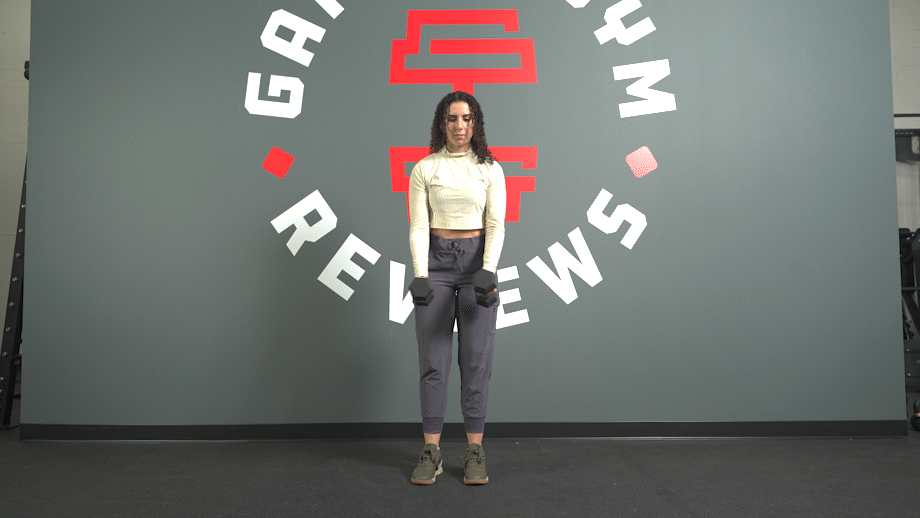
Move 6: Dumbbell Reverse Fly
Why it’s great: Reverse flyes rely on scapula adduction to hit the rear delts, as well as horizontal shoulder abductors like the rhomboids and both the middle and lower trapezius, making this a great trap exercise as well.
How to do it:
- Grab your dumbbells and lower your chest towards the floor by shifting the hips back. Let your arms fully extend towards the floor, adding a slight bend at the elbow.
- Raise the dumbbells up and out, squeezing the shoulder blades together.
- Slowly return to the starting position.
- Repeat as needed.
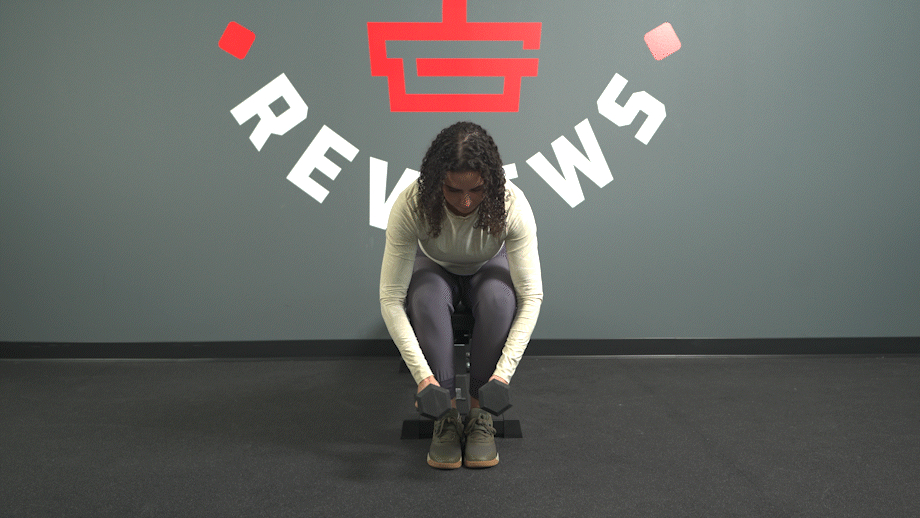
Move 7: Dumbbell Upright Row
Why it’s great: Prime movers of the upright row include the side delts and the traps, but this one provides activation throughout the back, trunk, core, and even the lower body to some degree.
How to do it:
- Stand with your feet shoulder-width apart, holding two dumbbells in front of your body.
- Pull the dumbbells up to chest height.
- Squeeze your back and shoulders at the top of the movement.
- Slowly return to the starting position.
- Repeat as needed.
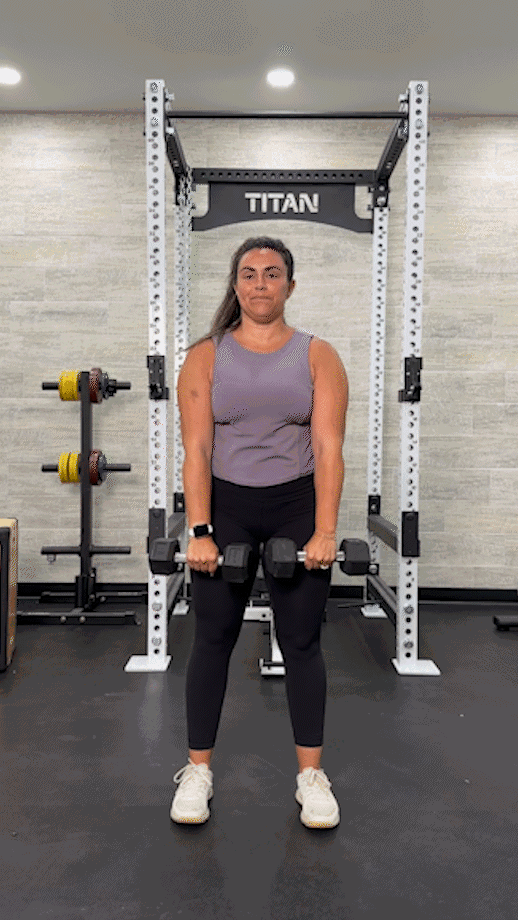
Putting it All Together
So, we know what exercises to do, but how will we structure our workout? How many reps to build muscle? Should we use light weights or go heavy?
As with all things fitness, the answer depends on your personal fitness goals.
According to a 2015 study published in the Journal of Strength and Conditioning Research1, “[multiple] sets of each exercise [are] superior to a single set of each exercise in promoting strength, muscle endurance, and muscle hypertrophy increases in upper-body musculature.”
Participants performed between three and five sets of eight to 12 reps, and so, for beginners, that’s exactly what we’d recommend. Pick a few of your favorite dumbbell shoulder exercises, no more than five, and select a dumbbell weight you can reliably move throughout each set.
It’s okay if you’re struggling on the last few reps toward the end of your set, but listen to your body and scale accordingly. If you’re obliterating the reps with ease, you perhaps went too light; whereas, if you’re struggling immediately, you have most definitely gone too heavy.
As you progress, your workout routine may become more sophisticated to support your goals.
A study published in 2002 in the European Journal of Applied Physiology2 provides insight on how to do this successfully. Researchers divided the study’s participants into three groups, each using a different rep scheme during their workouts.
Participant groups included a low rep scheme group performing few reps at a heavy weight, a high rep scheme group performing many reps at a light weight, and an intermediate rep scheme group doing some reps with moderate weight, serving as the middle ground of the other two groups.
According to the study, “maximal strength improved significantly more for the Low Rep group.” Meanwhile, “maximal aerobic power and time to exhaustion significantly increased at the end of the study for only the High Rep group.”
With this in mind, we’d recommend going heavy on three to five reps per exercise, if strength is your goal, keeping the weight light for approximately twenty reps, if muscular endurance and cardio are more your thing, or splitting the difference by doing eight to twelve reps per set if you’re interested in muscular hypertrophy.
For personalized fitness advice or customized program suited to your needs, consult a qualified fitness professional, coach, or certified personal trainer.
Deltoid Anatomy
Building shoulder strength involves targeting and strengthening various shoulder muscles, including the deltoids, trapezius, levator scapulae, and rotator cuff muscles. For hypertrophy, we’re focusing mostly on the deltoids3.
The deltoids are triangular muscles that enable various arm movements and provide support to the shoulder joint. As superficial extrinsic muscles, the deltoids are responsible for that classic rounded shoulder shape.
There are three distinct regions of the deltoid muscle:
- The anterior deltoid, or front deltoid, located on the front of the shoulder
- The lateral deltoid, or medial deltoid, located on the side of the shoulder
- The posterior deltoid, or rear deltoid, located on the back of the shoulder
The best dumbbell shoulder exercises provide activation in all of these areas, as well as adjacent muscle groups like the traps, triceps, upper back, lower back, and more.
A 2020 study published in the Journal of Human Kinetics4 compared deltoid muscle activity during shoulder exercises, like the overhead press and lateral raise, against dumbbell chest workout exercises, namely the bench press and dumbbell fly.
The study determined that shoulder exercises were not only superior at activating the deltoid muscle, but that different types of shoulder exercises provided different types of stimulation. Presses, for example, targeted the anterior deltoid, while lateral raises targeted, you guessed it, the lateral deltoid more.
That’s why our shoulder workout provides a wide variety of presses, raises, and other shoulder-specific movements, so you can get activation of every portion of the deltoid and build better overall shoulder strength.
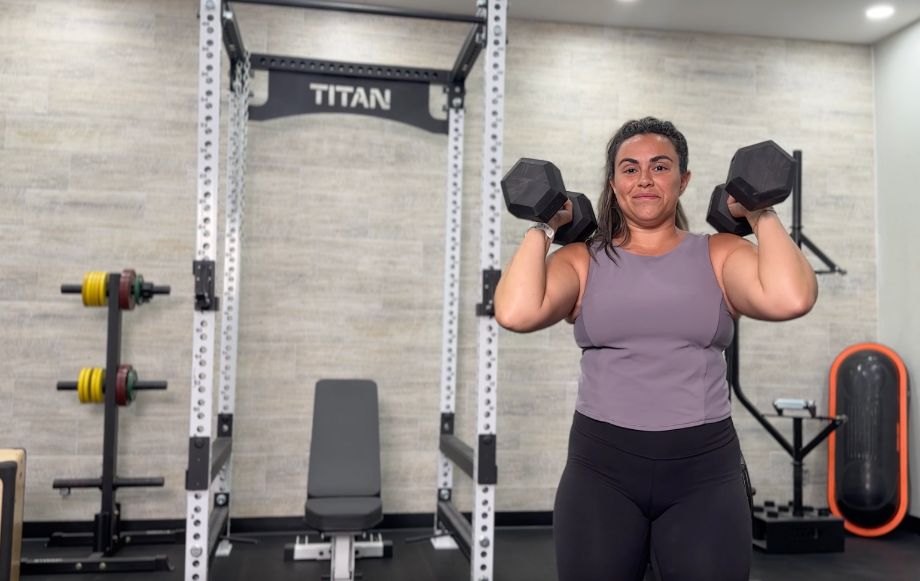
Benefits of Training Shoulders With Dumbbells
We’re acquainted with the benefits of shoulder strength training, like “[improved] muscle function, bone strength and formation, joint range of motion, joint stability, and athletic performance while decreasing injury risk,” according to a 2022 review published in Sports (Basel)5.
But what specifically makes using dumbbells so effective versus other training modalities?
A 2017 study published in the Journal of Strength and Conditioning6 compared both strength performance and muscle activation of the bench press and triceps extension exercises performed using a barbell, Smith machine, or dumbbells to assess which is superior.
The study found that “significantly higher total repetitions were achieved for the [dumbbell bench press],” and that dumbbells elicited greater muscle activity in the pectoralis major and biceps brachii compared to the barbell and Smith machine.
A 2018 study in the International Journal of Exercise Science7 built on these findings, observing that the dumbbell provided superior anterior deltoid activation during the overhead press exercise.
Dumbbells are less stable than barbells, requiring your body to work harder and recruit stabilizing muscles to complete the movements with proper form. They also enable a greater range of motion compared to a barbell or exercise machine, and enable unilateral movements, which are essential for correcting muscular imbalances.
There’s a lot to love about dumbbells, making them a smart way to train despite the name!
FAQs: Shoulder Workouts With Dumbbells
Can you grow shoulders with just dumbbells?
Studies have shown dumbbells provide ample activation of the shoulder muscles when performing shoulder-targeting exercises like the overhead press, front raise, dumbbell push press, and more.
So, as far as exercise is concerned, yes — dumbbells are sufficient for shoulder muscle growth.
Are dumbbells or barbells more effective at training shoulders?
Ah, dumbbells and barbells; the apples and oranges of strength training. They say you can’t compare apples and oranges, but you definitely can and so we’re going to compare them now.
Dumbbells have many benefits, including their versatility, the greater range of motion they enable, and the increased muscle activation they provide compared to a barbell.
However, dumbbells are inherently unstable, since they’re not attached to one another, meaning you’ll most likely move heavier weights when using a barbell. And, as we know, heavier weights mean greater strength gains. For this reason, we recommend using both in your workout routine, if possible.
How often should I train shoulders?
You might feel eager to work shoulder training into your workout every day, but that’s not the best idea. Instead of supercharging your results, you’re more likely to walk away with shoulder pain and/or injuries.
According to a 2017 study published in Muscle & Nerve8, it took the pectoralis major and triceps brachii 48 hours to fully recover after training. Sure, that’s for your chest and upper arms, but the recovery time should be similar for your shoulders.
Therefore, we recommend waiting at least forty-eight hours after shoulder training before hitting them again. In the meantime, focus on other muscle groups, perform active recovery, or take an actual rest day and relax. We’re sure you’ve earned it!
References
1. Radaelli R, Fleck SJ, Leite T, et al. Dose-response of 1, 3, and 5 sets of resistance exercise on strength, local muscular endurance, and hypertrophy. J Strength Cond Res. 2015;29(5):1349-1358. doi:10.1519/JSC.0000000000000758
2. Campos GE, Luecke TJ, Wendeln HK, et al. Muscular adaptations in response to three different resistance-training regimens: specificity of repetition maximum training zones. Eur J Appl Physiol. 2002;88(1-2):50-60. doi:10.1007/s00421-002-0681-6
3. Elzanie A, Varacallo M. Anatomy, Shoulder and Upper Limb, Deltoid Muscle. In: StatPearls. Treasure Island (FL): StatPearls Publishing; May 15, 2022.
4. Campos YAC, Vianna JM, Guimarães MP, et al. Different Shoulder Exercises Affect the Activation of Deltoid Portions in Resistance-Trained Individuals. J Hum Kinet. 2020;75:5-14. Published 2020 Oct 31. doi:10.2478/hukin-2020-0033
5. Seguin RC, Cudlip AC, Holmes MWR. The Efficacy of Upper-Extremity Elastic Resistance Training on Shoulder Strength and Performance: A Systematic Review. Sports (Basel). 2022;10(2):24. Published 2022 Feb 14. doi:10.3390/sports10020024
6. Farias DA, Willardson JM, Paz GA, Bezerra ES, Miranda H. Maximal Strength Performance and Muscle Activation for the Bench Press and Triceps Extension Exercises Adopting Dumbbell, Barbell, and Machine Modalities Over Multiple Sets. J Strength Cond Res. 2017;31(7):1879-1887. doi:10.1519/JSC.0000000000001651
7. Dicus JR, Holmstrup ME, Shuler KT, Rice TT, Raybuck SD, Siddons CA. Stability of Resistance Training Implement alters EMG Activity during the Overhead Press. Int J Exerc Sci. 2018;11(1):708-716. Published 2018 Jun 1.
8. Ferreira DV, Gentil P, Soares SRS, Bottaro M. Recovery of pectoralis major and triceps brachii after bench press exercise. Muscle Nerve. 2017;56(5):963-967. doi:10.1002/mus.25541


